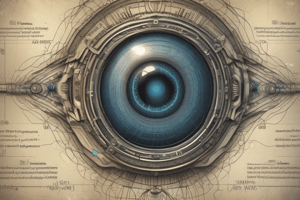Podcast
Questions and Answers
Which of the following are included in the Station 1 Skills? (Select all that apply)
Which of the following are included in the Station 1 Skills? (Select all that apply)
- Slit Lamp
- Blood Pressure (correct)
- Case History (correct)
- Saccades (correct)
What are the Station 2 Skills? (Select all that apply)
What are the Station 2 Skills? (Select all that apply)
- Punctal Plugs (correct)
- Slit Lamp (correct)
- Distance Refraction
- Gonio (correct)
Which skills are part of Station 3? (Select all that apply)
Which skills are part of Station 3? (Select all that apply)
- Binocular balance (correct)
- Blood Pressure
- Distance Refraction (correct)
- BIO
What is glaucoma?
What is glaucoma?
How does one typically diagnose cataracts?
How does one typically diagnose cataracts?
What are common treatments for dry eye? (Select all that apply)
What are common treatments for dry eye? (Select all that apply)
What condition describes the clouding of the eye's lens?
What condition describes the clouding of the eye's lens?
What is the primary issue with macular degeneration?
What is the primary issue with macular degeneration?
Pink eye can only be caused by bacteria.
Pink eye can only be caused by bacteria.
The ________ is responsible for focusing light onto the retina.
The ________ is responsible for focusing light onto the retina.
Match the following conditions with their descriptions:
Match the following conditions with their descriptions:
Flashcards are hidden until you start studying
Study Notes
Station 1 Skills
- Conduct case history including chief complaint and secondary complaints.
- Perform patient education on eye conditions like glaucoma and cataracts.
- Assess extra ocular movements (EOMs) and saccades for coordination.
- Execute confrontation tests for peripheral vision.
- Conduct near cover test and near point of convergence (NPC) assessments.
- Evaluate pupils for size, reactivity, and any afferent pupillary defects (APD).
- Measure blood pressure to determine vascular health relevance to eye conditions.
- Analyze ophthalmic lenses for proper fitting and correction.
Station 2 Skills
- Utilize slit lamp for microscopical examination of anterior eye structures.
- Perform Goldmann Applanation Tonometry (GAT) to measure intraocular pressure (IOP).
- Conduct gonioscopy to examine the anterior chamber angle.
- Insert and evaluate punctal plugs for dry eye treatment.
- Manage contact lenses (SCL and GP) for insertion, evaluation, and removal.
Station 3 Skills
- Conduct retinoscopy to assess refractive error and measure pupillary distance (PD).
- Refine distance refraction to determine precise corrective lens prescription.
- Test binocular vision balance through phoria assessment and vergence at distance.
- Analyze binocular cross cylinder (BCC), negative relative accommodation (NRA), and positive relative accommodation (PRA) for convergence assessment.
Station 4 Skills
- Conduct Binocular Indirect Ophthalmoscopy (BIO) to examine the retina's health.
- Perform dilated lens examination to assess vitreous and fundus structures.
EOMs and Saccades
- Evaluate eye muscle function and range of motion without finger guidance.
- Assess saccade accuracy using rods to measure response speed and precision.
Confrontations
- Measure peripheral vision at a one-meter distance with full illumination.
- Count fingers in each quadrant to evaluate visual field integrity.
Near Cover Test and NPC
- Test alignment for near vision with adequate lighting.
- Observe for blur, break, and recovery during convergence assessment.
Pupils
- Measure pupil size under bright and dim light conditions.
- Evaluate direct and consensual responses as well as near reactions.
Blood Pressure
- Monitor blood pressure while ensuring proper arm support to prevent artery compression.
- Important for identifying systemic conditions affecting eye health.
Slit Lamp Examination
- Assess health of anterior segment including lids, conjunctiva, cornea, and anterior chamber.
- Document findings of any debris or pathologies and measure intraocular pressure.
Gonioscopy
- Use contact lens and anesthetic for assessing drainage systems in the eye.
- Identify any anatomical abnormalities that could affect IOP.
Punctal Plugs
- Insert collagen implants to help retain tears in the eye.
- Follow insertion techniques carefully to ensure effectiveness.
Contact Lens Management
- Evaluate SCL for fit, coverage, and movement.
- Conduct GP assessments for proper centering and fit.
- Adhere to hygiene protocols for lens handling.
Retinoscopy
- Estimate prescription using light reflection from the retina.
- Adjust working distance for accurate measurements.
Distance Refraction
- Refine prescription by fogging and unfogging to assess clarity.
- Balance the vision system for optimal outcomes in refractive status.
Accommodation Testing
- Measure the ability of eyes to focus on nearby objects using BCC and NRA/PRA methods.
- Distinguish between strong and weak responses to accommodation demands.
BIO and Fundus Examination
- Inspect posterior segments for tears, holes,/vessel integrity during BIO.
- Evaluate the central part of the retina and optic nerve health to identify potential diseases.
Studying That Suits You
Use AI to generate personalized quizzes and flashcards to suit your learning preferences.



